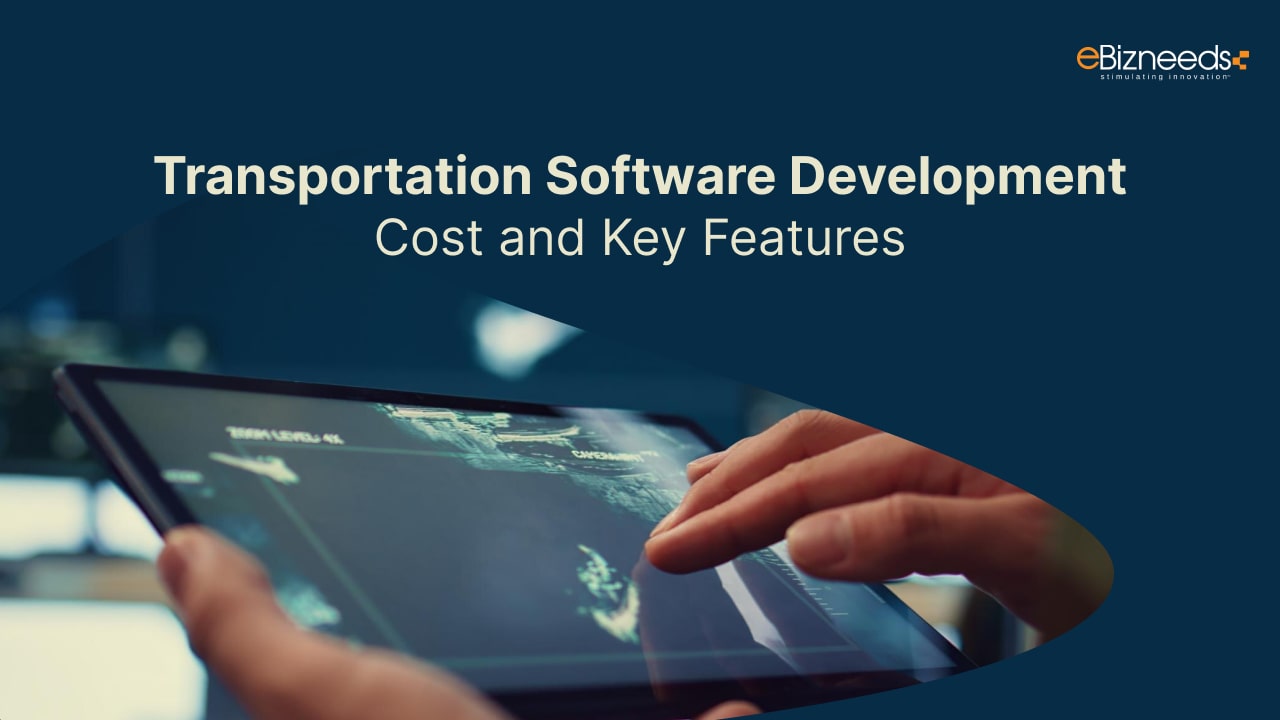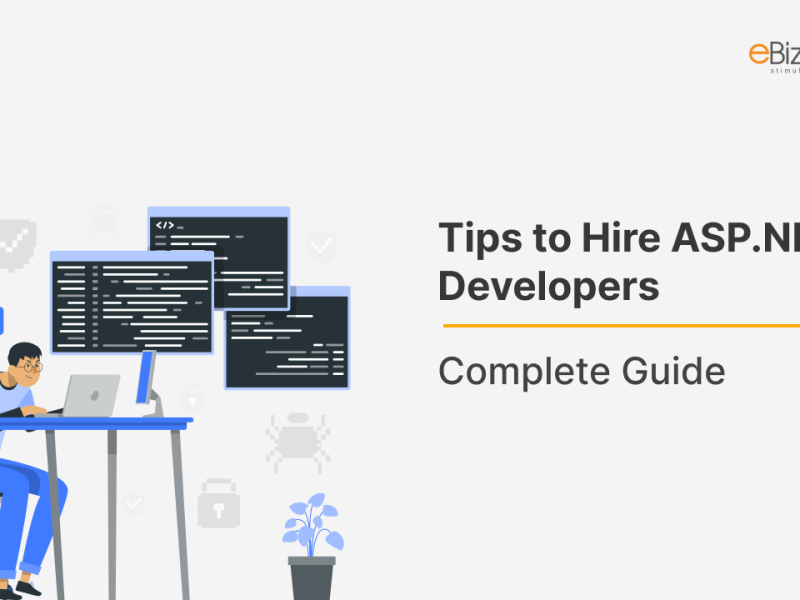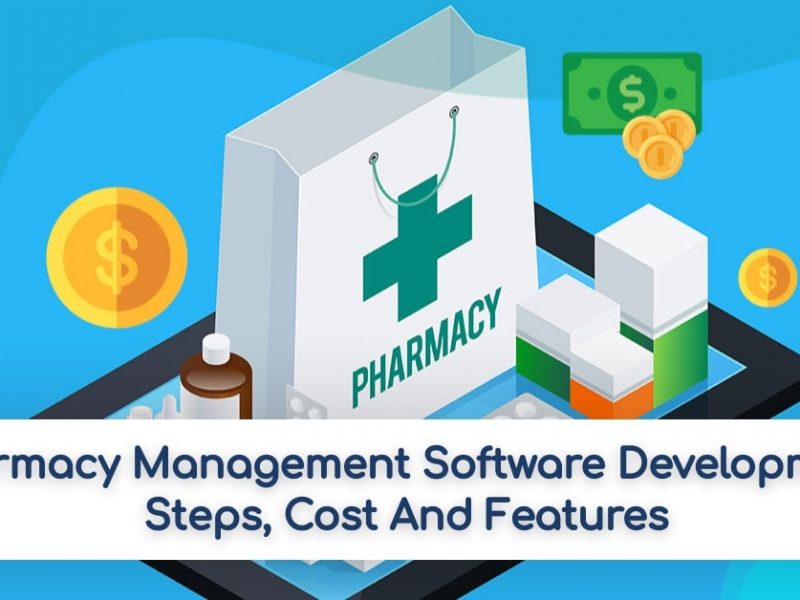Last updated on November 26th, 2024 at 10:02 am
Want to build your own transport management software? You came to the right web page. Businesses today operate in a fast-changing and unpredictable environment. To stay ahead, many companies are turning to transport management software. Here is a complete guide to you about all the necessary points of Transportation Software Development in 2024.
Transportation software is now a must-have for entrepreneurs in the logistics and transportation industry. This type of software provides flexible, scalable, and real-time management of transportation across the entire supply chain. It helps automate key processes, ensuring efficient and timely deliveries.
With advanced technology, transportation software makes operations smoother, improves customer service, and boosts business growth. Doesn’t matter, if you want to track shipments or check the delivery route, the TMS tool will meet all your business requirements.
By using this software, businesses can reduce delivery times, cut freight costs, and increase warehouse productivity. The overall procedure helps to satisfy customers and a more efficient supply chain. A TMS is an essential part of supply chain management that focuses on transportation logistics. A TMS allows an order management system to connect with a warehouse or distribution center.
In this blog, we will cover all the important topics related to creating TMS software, key features to include, the challenges businesses face without TMS, the benefits of TMS and the cost of Transportation Software Development.
Understanding the Transportation Management Software
Transport management software is designed to manage, optimize, and enhance an organization’s logistics and transportation processes. Helps companies involved in moving vehicles and goods to better organize and coordinate the transportation of products or people. It boosts how well operations run, reduces transportation costs, and improves the clarity of the entire transport process. It includes automation, streamlining tasks, and generating reports for further review. If you entered in such industries like retail, automotive, logistics, manufacturing, or e-commerce then you should take advantage of transportation management software.
How does TMS System Work?
Transport software helps manage and improve the movement of goods and individuals as well. It figures out the best routes based on factors like distance and traffic and makes them more efficient. It also helps with managing fleets, inventory, and freight, creating schedules, assigning tasks, and analyzing data. The software uses advanced technologies such as telematics, GPS, machine learning, AI, IoT, and cloud computing to operate effectively.
Market Overview of Transport Software
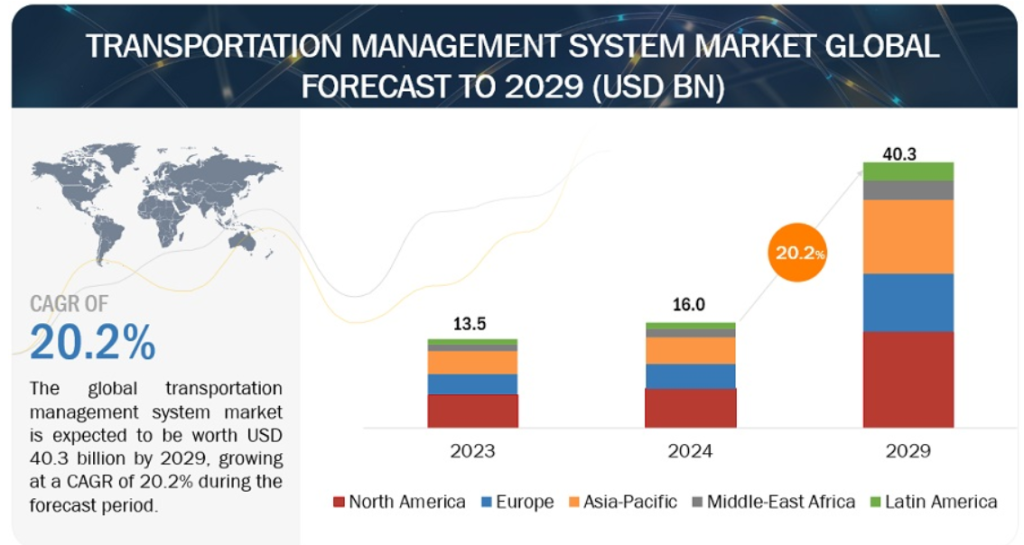


- The result has shown that more than 51% of shippers thought 3PLs needed transport management system software for effective planning.
- The global market for transportation management software was reached $3.45 billion in the year 2018. This shows an annual growth rate of 6.8%.
- North America is the biggest market for this software that’s what makes it about one-third of the total share in the year 2018 due to higher spending on transport optimization and automation.
- The market is expected to reach a value of USD 33.3 billion by 2028 which is growing at rate of 19.7% each year.
If you want to create a transport software app you should reach out to a reliable company that offers a high-quality development service.
Major Benefits of Transportation Management Software
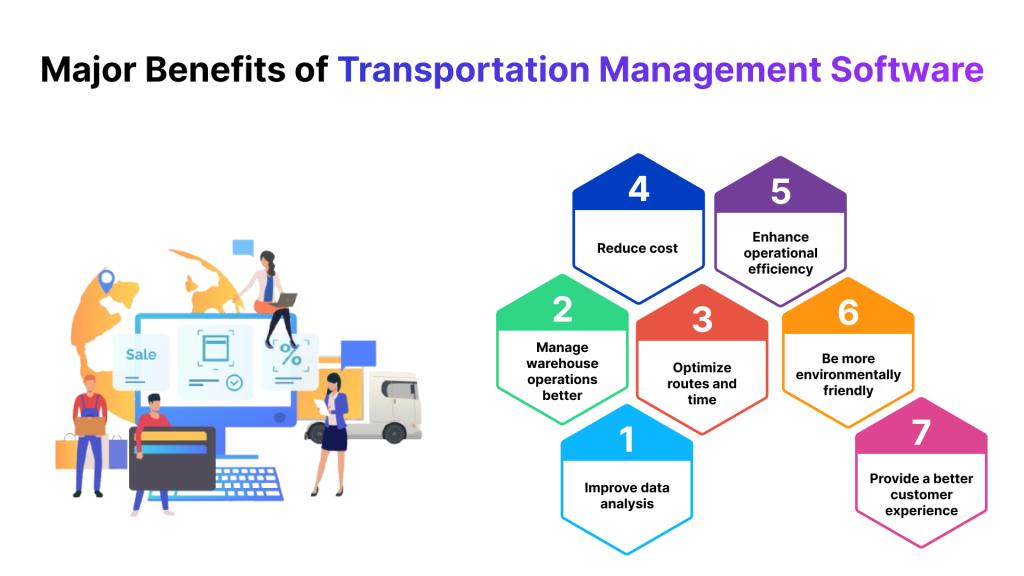


Creating a successful transportation management software isn’t finished until you know the major advantages of it. Here are the key benefits of investing in transportation software development. This includes advantages for logistics and transportation companies as well as any business that depends on transportation services.
Improve data analysis
The software comes with built-in data analytics tools that track important details like order fulfilment, routes, and delivery times. Managers can get maximum advantage of this in order to find opportunities, problems, risks, trends, and areas for improvement. According to Forbes, 85% of companies believe that data analysis is key to their success and growth.
Manage warehouse operations better
If your business has warehouses, you can link transport software with warehouse management systems to improve inventory tracking, management, and delivery planning. According to a SupplyChain 24/7 survey, 36% of people get better insights by combining warehouse and transport software.
Optimize routes and time
The automation feature in transport software handles all the calculations needed to find the best route for delivering goods and passengers. It takes into account factors like traffic, distance, road and vehicle conditions. By using optimized routes, you can save both fuel and time. Research studies show that optimizing routes can cut fuel costs by up to 20%.
Reduce cost
Another benefit of creating a transportation management system is cutting down the costs. This means, the tool helps businesses to save money and boost profits. Moreover, it can lower costs related to manual labor and general transportation.
Enhance operational efficiency
Using GPS technology, transport software tracks the real-time location and status of vehicles. This helps you quickly adjust plans, avoid delays, and forecast deliveries more accurately. According to a survey by Verizon Connect, 75% of people agree that GPS tracking greatly improves vehicle efficiency.



Be more environmentally friendly
Since many vehicles use non-renewable fuels and release harmful gases, better route planning can reduce vehicle idle time in traffic which helps cut down thousands of tons of CO2 emissions.
Provide a better customer experience
Using transport software with real-time data on vehicle location and delivery status can greatly improve customer experience. Did you know that 87% of customers purchasing decisions are influenced by delivery time? With this transportation management software development, you can ensure timely deliveries, enhance customer satisfaction and increase sales.
Top 5 Popular Transportation Management Software
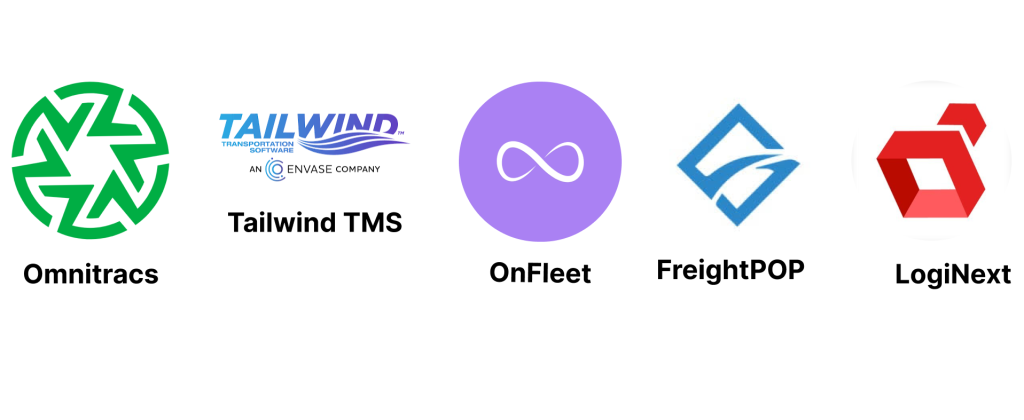


Here are the top 5 transport software options you can explore for inspiration on their features and capabilities.
OnFleet
OnFleet focuses on last-mile delivery and local shipment making it ideal for industries like courier services, food & beverages, furniture, pharmacy retail and e-commerce. This app helps you impress customers, grow your business, and improve efficiency. It features complete route optimization, dispatch, and communication tools along with an analytics platform. The software includes automatic notifications, easy integrations, and robust APIs.
LogiNext
LogiNext is designed to provide smooth delivery and an excellent customer experience. It handles the complete planning and execution of goods transportation. The system is easy to set up and can be integrated with your current setup. Key features include real-time tracking, geofencing, fleet performance monitoring, 3D packing optimization, capacity management, carrier management, and customer invoicing.
Omnitracs
Omnitracs transport management software is created to boost your business efficiency, enhance driver safety and retention, and improve your return on investment in logistics and transport. It provides a complete fleet management solution for trucking which mainly includes features like telematics, payments and factoring, fuel cards, compliance, and accounting.
FreightPOP
A cloud-based transportation management system, FreightPOP is specially created for manufacturers, distributors, retailers, and 3PLs. It’s easy to use, integrates quickly with your current system, and offers a fast setup. With advanced planning, auditing, and analytics features, it helps you find ways to save. It’s a top choice for transport management software, reducing data entry time, minimizing errors, and providing insights for better decision-making.
Tailwind TMS
Tailwind is a cloud-based software for trucking and freight managemebnt that doesn’t require a setup fee or a contract. You can start with a free trial. It’s perfect for mid-sized and growing businesses. Tailwind aims to make shipments faster and more cost-effective compared to traditional logistics methods.
Key Features of Creating Transportation Management Software
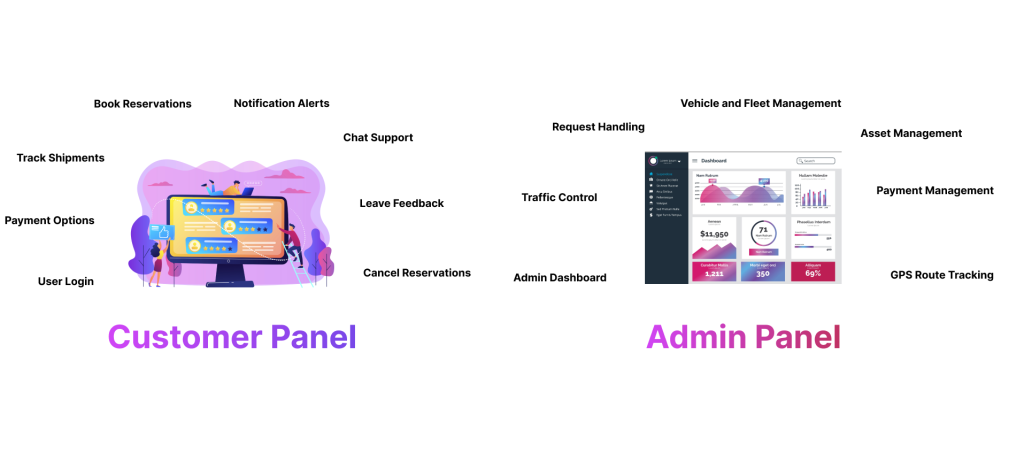


In this section, we cover the essential features of both the customer and admin panels that you need to know before starting development.
Customer Panel
User Login
Consumers can access the transportation software dashboard by signing up or logging in with their social media accounts or email addresses.
Payment Options
Customers will find this option handy for making payments. For a secure checkout, they can choose from several payment methods available.
Track Shipments
A customer can check the status of their order from a company that makes transportation software to see how it’s progressing.
Book Reservations
Customers can use this option to schedule their transportation management bookings for a time and date that suits them best.
Notification Alerts
Users can get notifications for reservations, cancellations, order dispatch, deliveries, and invoices. This helps both admins and users stay updated on their activities.
Chat Support
If customers need more details about their orders from the transportation app development company, they can contact the admin and driver using this feature.
Leave Feedback
Through this feature customers can leave feedback or comments t for their service. Also, they can rate the driver or the transportation software.
Cancel Reservations
Customers can use this feature to cancel their booking before the service is delivered. This helps prevent other customers from getting incorrect bookings.
Admin Panel
Admin Dashboard
Administrators can view all activities in the transportation software by logging into the dashboard. They can also manually add or update information as needed.
Traffic Control
Admins can use data technology, advanced systems, and traffic modeling tools to quickly analyze traffic, detect accidents, and track movements in real-time.
Vehicle and Fleet Management
The admin can easily manage resources and collect, analyze, and display data on vehicle locations, engine performance, weather conditions, and driver behavior.
Request Handling
Admins can review and either approve or reject requests for package pickup, delivery, or transport. This helps prevent any misleading or inappropriate suggestions.
Request Handling
Admins can review and either approve or reject requests for package pickup, delivery, or transport. This helps prevent any misleading or inappropriate suggestions.
Asset Management
The transportation management software uses IoT devices, RFID, GPS,and QR codes to track company assets. These tools precisely monitor and manage valuable inventory.
Payment Management
The admin can easily manage client card or COD payments and review payment histories to monitor any payment method a user chooses within the app.
GPS Route Tracking
The admin can use GPS route tracking to see where the driver is and how they are getting to their destination.
Challenges That TMS Software Helps Business Overcome
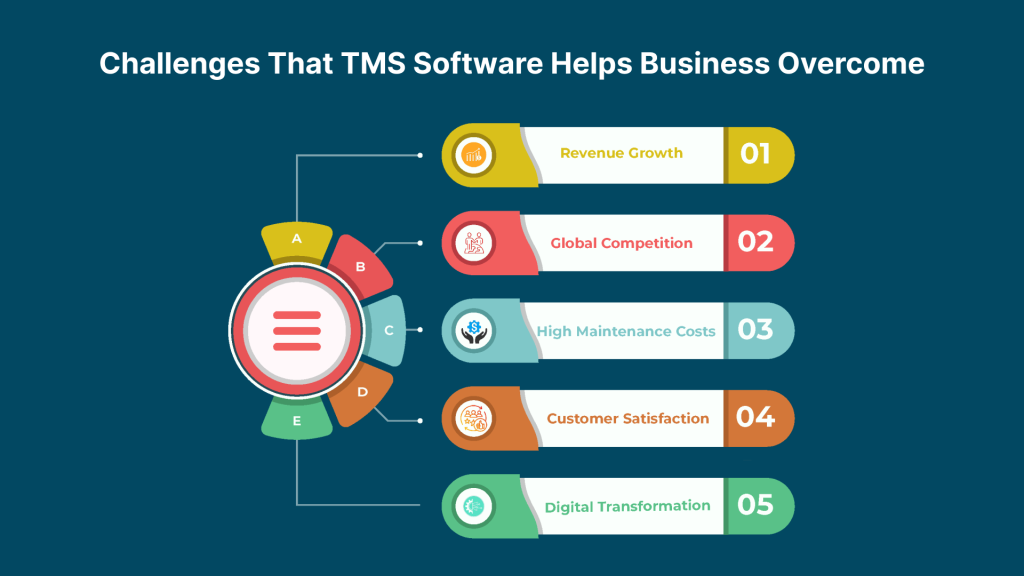


It’s important to understand that businesses encounter many problems without the right TMS software. In this section, we highlight several challenges related to transportation that companies often face.
Revenue Growth
We know that earning high income and ROI in transportation can be tough because of complex route planning, driver behavior, and expanding fuel networks. However, Transportation Management Software development can help. It offers unique features and interfaces that make it easier for businesses to boost their revenue and profit more quickly.
Global Competition
With the rising demand for transport management system software, standing out from global competitors is tough. Many businesses are aiming to create advanced transportation software to help them grow and set themselves apart. As the software industry in transportation expands, it will naturally boost its competitiveness and customer base.
High Maintenance Costs
The cost of maintaining resources is among the highest in transport management system software development. However it is vital to know that maintenance expenditures decrease the total profit made by the transportation sector. Transportation management software is very profitable to help businesses get beyond financial constraints and generate economic transportation services.
Customer Satisfaction
It’s important to understand that as technology evolves, customer preferences change. Today’s customers are more knowledgeable about transportation and related technologies. This means their expectations are higher, especially when it comes to transparency and communication. To meet these expectations, many businesses have started using TMS software to provide better value to their customers.
Digital Transformation
Many transportation businesses still rely on old logs, documents and records which can be a problem as government digital standards are getting stricter. TMS software offers a simple and effective way for companies to move away from outdated tracking methods and update their technology.
How to Create Transportation Management Software
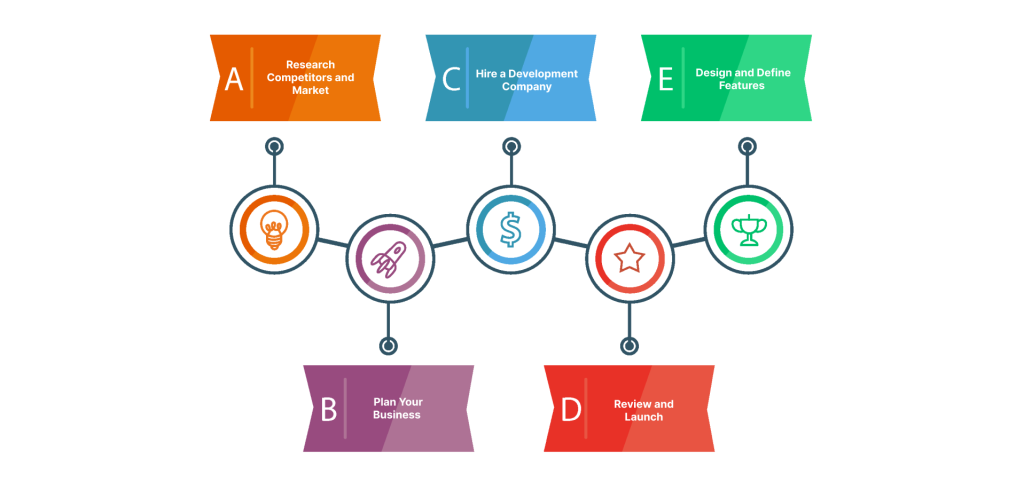


Here you will get to know how to create TMS software for your business. We have shared an easy guide to help you through the process.
Research Competitors and Market
The first step in developing transportation software is researching the market and competition. This initial phase involves analysing the market to understand the current supply of transportation software. By examining market trends, you’ll determine if it’s the right time to test your idea.
Also studying your competitors is key. Understanding their growth patterns and marketing strategies helps you identify their strengths and mistakes. This information is valuable for creating better software.
Plan Your Business
The second step in building TMS software is deciding on your plan. It’s important to set clear business objectives because understanding these goals is key. Developing a business plan also involves creating a marketing strategy and budgeting for it. In this step, you need to define your business concept by developing a business model, revenue model, and other elements related to transportation management software. Many companies hire software development firms to get expert advice throughout this process.
Hire a Development Company
The third and most crucial step in building TMS software is to hire a top-notch web development company. You’ll need experienced developers to create your transportation software. Choose a company with a strong track record in transport management software development if you want a high-quality app. Discuss your software ideas with them and then wait for them to build your software to get the best results.
Design and Define Features
At this stage, it’s important to define the UI/UX design and feature preferences for your software. Start by creating a list of all the features and styles you want for your target audience. Your mobile app development company will then create a prototype that includes all these features. This prototype will serve as a sample during the development phase.
Review and Launch
After building your transportation management software, it’s crucial to have your development team thoroughly test the application. Many companies skip this step and later regret it when they find flaws or bugs in the live app. Make sure your developers provide a thoroughly tested product. Identify and fix any issues before the final launch. Following these steps will help ensure a successful software release.
Technology Stack Used For Transportation Management Software
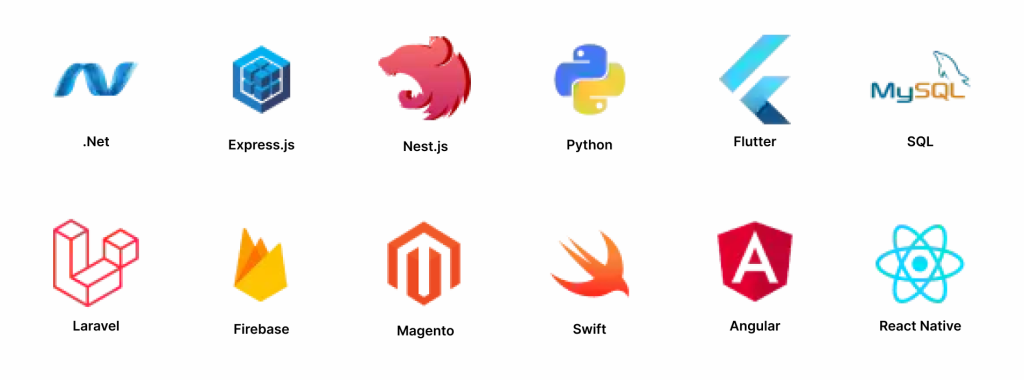


- Back-end
Node.js, Ruby on Rails, Django, ASP.NET
- Front-end
HTML, CSS, JavaScript (React, Angular)
- Integrations
RESTful API, GraphQL
- Database
MySQL, PostgreSQL, MongoDB
- Cloud Services
Amazon Web Services (AWS), Microsoft Azure
How Much Does it Cost to Build a Transport Management Software?
There are many factors that directly impact the cost of Transport Management Software Development. These features mainly include features, functions, design, developer location and the platform you choose. On the basis of these factors, the cost typically ranges from $20,000 to $150,000. We recommend outsourcing development as it offers high-quality services at more affordable prices.
Moreover, the location of developers also impacts the price. For instance, in North America, developers charge $100-$200 per hour. Whereas, in Asia expertise costs between $20-$100 per hour. Here, we have shared the average hourly rates across different regions.
- South America ($35-$60)
- North America ($100-$200)
- Australia ($80-$120)
- Asia ($20-$40)
- Western Europe ($75-$150)
- Central and Eastern Europe ($25-$70)
Why Choose eBizneeds for Transportation Management Software Development?



Are you searching for a reliable Transportation Management Software Development company? eBizneeds is the best choice which offers a top-quality software development service. With over 20 years of experience building top-quality software, apps and web applications, our team has developed strong logistics and transportation software development expertise. Our skilled software developers can connect transport management software with third-party tools like Xero, Google Maps, Salesforce, SAP ERP and LogitaaS. We also provide flexible options for working together, such as dedicated teams or outstaffing. Get in touch with us to discuss your needs.
Conclusion
At last but not least, now you have a clear understanding of how to build a successful transportation management software including its features, benefits, challenges, and cost analysis. Remember creating TMS software is not simple as it needs a special skill set and experienced developers. To get the best results, it’s important to choose a top mobile app development company. So, what should you do next? Reach out to our designer team to turn your TMS software vision into reality. Our team has more than 15 years of experience in software development and has successfully delivered multiple projects to happy clients. If you have any requirements then share it today!
FAQs
The time it takes to develop transport management software depends on its features and complexity. Usually, the whole process takes about 12 to 15 weeks of work.
Yes, over time, the advantages like saving money and time, keeping data updated, and more will make the initial cost worthwhile. It will also boost efficiency with real-time tracking, automate daily tasks, and improve customer satisfaction.
Transportation apps provide many advantages such as saving time and money, improving efficiency with real-time tracking, automating daily tasks, offering better customer experiences, and improving data analysis
Yes, we design transport management software to easily connect with the current systems in your logistics or transport company. This lets you use all the information on the go which offers smooth operations.
If you want to develop a transport app then it includes a few steps:-
1. Start by deciding what the app will do. Whether it’s a separate SaaS solution or part of your logistics system.
2. Do some market research to find your target users and competitors.
Pick a way to make money from the app.
3. Next, choose the integrations you need, like GPS or payment systems.
4. Lastly, find a skilled development team to design, build, test, and launch the app.



Naveen Khanna is the CEO of eBizneeds, a company renowned for its bespoke web and mobile app development. By delivering high-end modern solutions all over the globe, Naveen takes pleasure in sharing his rich experiences and views on emerging technological trends. He has worked in many domains, from education, entertainment, banking, manufacturing, healthcare, and real estate, sharing rich experience in delivering innovative solutions.
